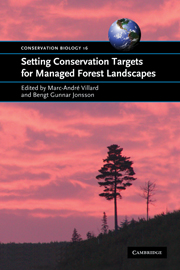Book contents
- Frontmatter
- Contents
- List of contributors
- Foreword
- Acknowledgements
- 1 A plea for quantitative targets in biodiversity conservation
- 2 Setting conservation targets: past and present approaches
- 3 Designing studies to develop conservation targets: a review of the challenges
- 4 Testing the efficiency of global-scale conservation planning by using data on Andean amphibians
- 5 Selecting biodiversity indicators to set conservation targets: species, structures, or processes?
- 6 Selecting species to be used as tools in the development of forest conservation targets
- 7 Bridging ecosystem and multiple species approaches for setting conservation targets in managed boreal landscapes
- 8 Thresholds, incidence functions, and species-specific cues: responses of woodland birds to landscape structure in south-eastern Australia
- 9 Landscape thresholds in species occurrence as quantitative targets in forest management: generality in space and time?
- 10 The temporal and spatial challenges of target setting for dynamic habitats: the case of dead wood and saproxylic species in boreal forests
- 11 Opportunities and constraints of using understory plants to set forest restoration and conservation priorities
- 12 Setting conservation targets for freshwater ecosystems in forested catchments
- 13 Setting quantitative targets for recovery of threatened species
- 14 Allocation of conservation efforts over the landscape: the TRIAD approach
- 15 Forest landscape modeling as a tool to develop conservation targets
- 16 Setting targets: tradeoffs between ecology and economics
- 17 Setting, implementing, and monitoring targets as a basis for adaptive management: a Canadian forestry case study
- 18 Putting conservation target science to work
- Index
- References
14 - Allocation of conservation efforts over the landscape: the TRIAD approach
Published online by Cambridge University Press: 05 June 2012
- Frontmatter
- Contents
- List of contributors
- Foreword
- Acknowledgements
- 1 A plea for quantitative targets in biodiversity conservation
- 2 Setting conservation targets: past and present approaches
- 3 Designing studies to develop conservation targets: a review of the challenges
- 4 Testing the efficiency of global-scale conservation planning by using data on Andean amphibians
- 5 Selecting biodiversity indicators to set conservation targets: species, structures, or processes?
- 6 Selecting species to be used as tools in the development of forest conservation targets
- 7 Bridging ecosystem and multiple species approaches for setting conservation targets in managed boreal landscapes
- 8 Thresholds, incidence functions, and species-specific cues: responses of woodland birds to landscape structure in south-eastern Australia
- 9 Landscape thresholds in species occurrence as quantitative targets in forest management: generality in space and time?
- 10 The temporal and spatial challenges of target setting for dynamic habitats: the case of dead wood and saproxylic species in boreal forests
- 11 Opportunities and constraints of using understory plants to set forest restoration and conservation priorities
- 12 Setting conservation targets for freshwater ecosystems in forested catchments
- 13 Setting quantitative targets for recovery of threatened species
- 14 Allocation of conservation efforts over the landscape: the TRIAD approach
- 15 Forest landscape modeling as a tool to develop conservation targets
- 16 Setting targets: tradeoffs between ecology and economics
- 17 Setting, implementing, and monitoring targets as a basis for adaptive management: a Canadian forestry case study
- 18 Putting conservation target science to work
- Index
- References
Summary
INTRODUCTION
The TRIAD forest management concept involves designating forest reserves and intensively managed areas within a landscape matrix managed by silvicultural systems derived from principles of ecological forestry (Seymour and Hunter 1999). By increasing timber yields per hectare in a strategically chosen zone, many fewer hectares are needed to produce the same forest-wide harvest, thus enhancing managers' ability to address other values such as biodiversity on the remaining areas (Sedjo and Botkin 1997). Introduced by Seymour and Hunter (1992), the concept can be traced to earlier work of Clawson (1974, 1977), Seymour and McCormack (1989), and Gladstone and Ledig (1990). Contemporary examples include grassland and aquatic ecosystems (Hunter and Calhoun 1996), an organizing framework for silvicultural research and management in the Great Lakes region (Palik et al. 2004), an illustration of “biodiversity exchanges” (Brown et al. 2006), and an analysis of public forest land in west Australia (Stoneman 2007). Indeed, many authors (e.g. Binkley 1997; Sahajananthan et al. 1998; Messier and Kneeshaw 1999; Taylor 1999) have explored the single-use zoning concept under various naming conventions.
The early 1990s was a tumultuous time in North American forestry, as influential ecologists began to question publicly the agricultural and “manage-everywhere” paradigms of traditional sustained yield forestry and outlined an alternative “New Forestry” (Franklin 1989; Gillis 1990), a concept that quickly morphed into ecosystem management as it was embraced by the USDA Forest Service (Salwasser 1994).
- Type
- Chapter
- Information
- Setting Conservation Targets for Managed Forest Landscapes , pp. 283 - 303Publisher: Cambridge University PressPrint publication year: 2009
References
- 7
- Cited by

